Thwarted at the first attempt, a return to Sarek was inevitable. Accompanied by two hairy companions and equipped with the appropriate gear for once, how would the Gentleman Explorer fair? With 100 kph winds and swathes of open water, it would be an inauspicious start to the adventure.
Day 1
The winter of ‘23 got off to a beastly start with record breaking warm temperatures in the Arctic, affecting both wildlife and many a ski trip alike. Such were the circumstances that Ian and I started our Sarek expedition, in the far north of the Swedish Arctic, in conditions that might befall one on a chilly spring morning in Britain. With temperatures on the positive side of zero degrees, it was a disconcerting start to our two week adventure through those spectacular valleys of Sarek national park. The only reminder of our remote and inhospitable location were the hundred kilometre per hour winds that howled around us.
While many might rejoice at the prospect of milder conditions in a landscape where the mercury can plummet to -40 degrees, I was of no such mindset. Milder weather means thinner ice on the mountain lakes and rivers which we would have to navigate for a significant proportion of the route. With this in mind, we set off up the winding track through the woods from the little village of Kvikkjokk that was so familiar of my unsuccessful expedition two years earlier. If you are unfamiliar with my previous toil, I urge you to first read either the articles concerned from that adventure, or my introductory article found here.
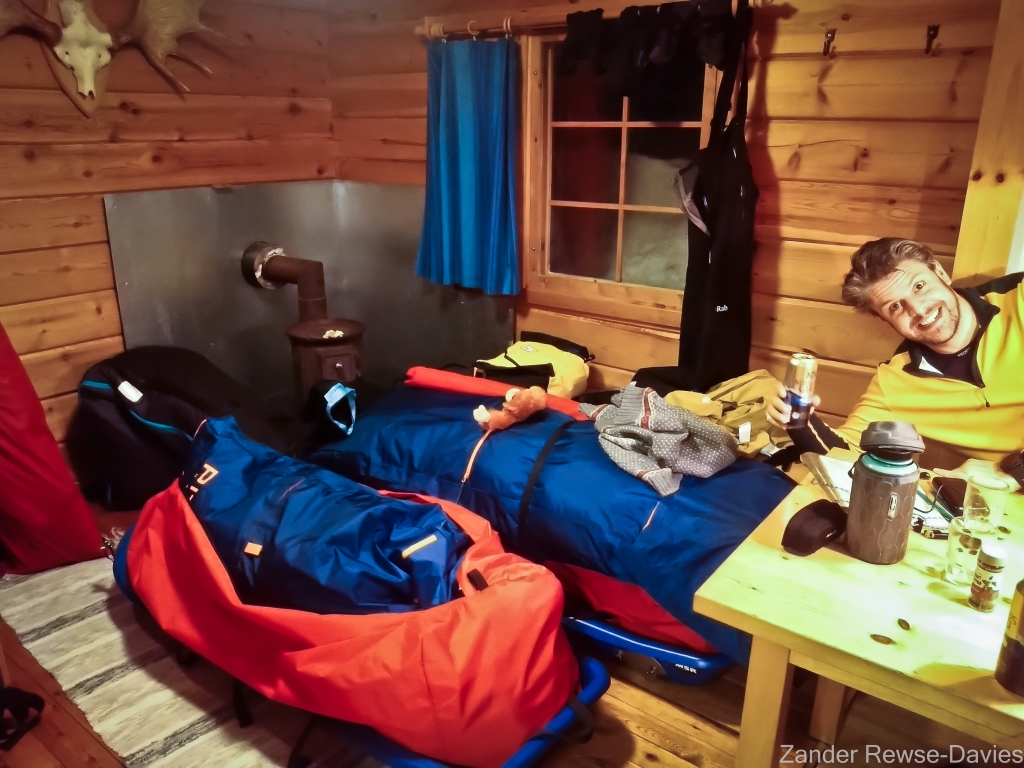
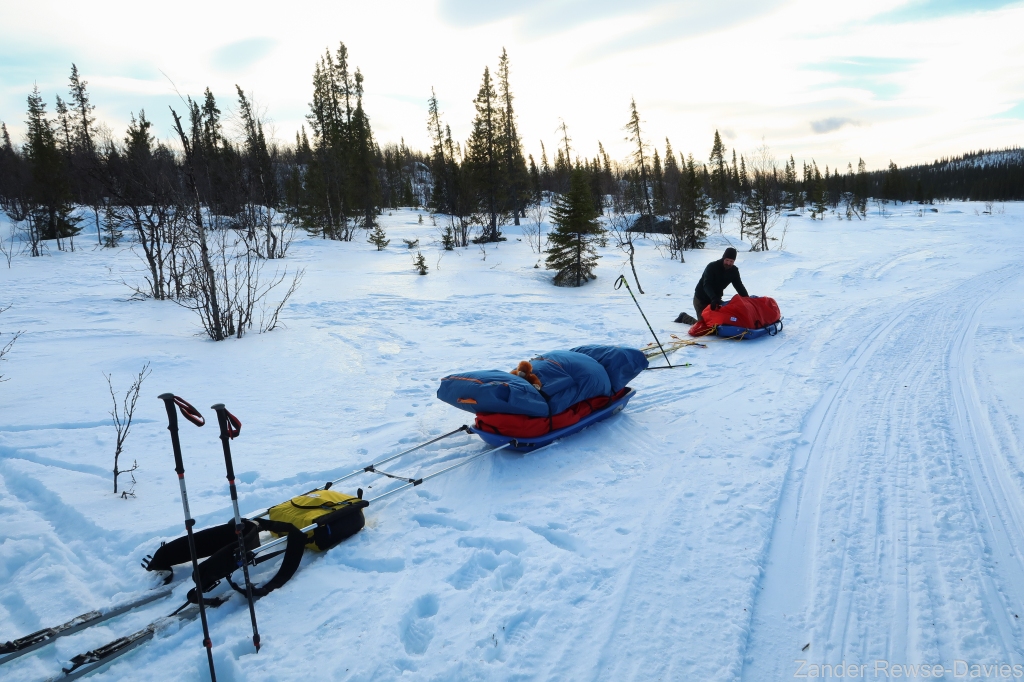
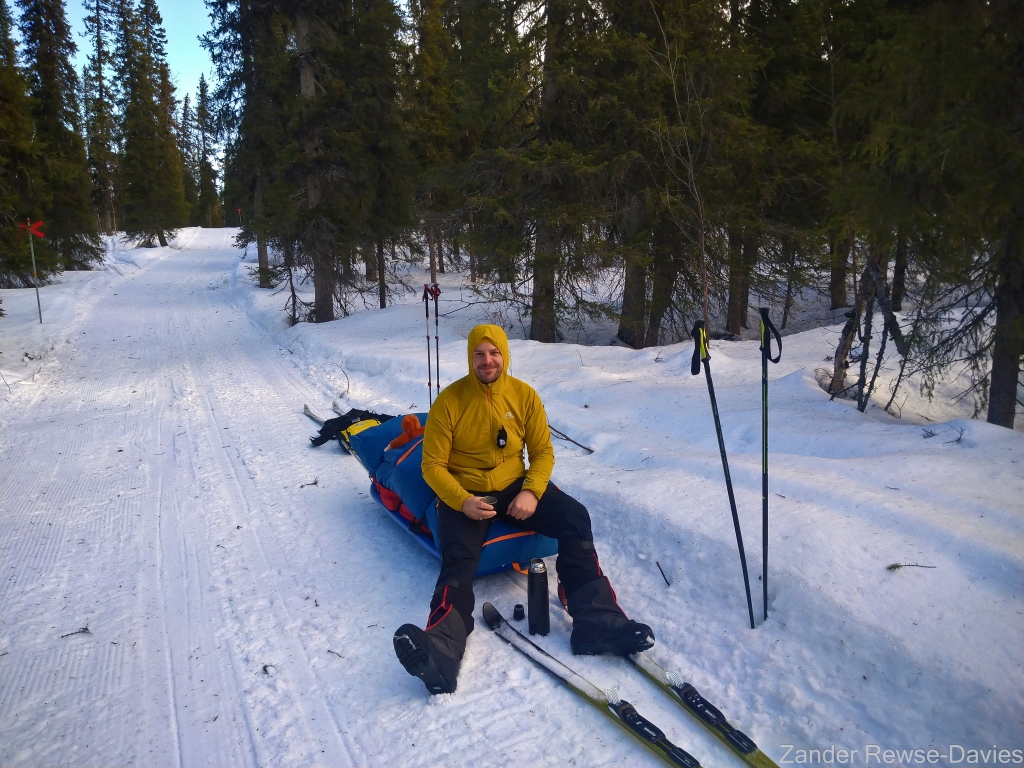
Having swapped my lethargic powder skis and Alpine touring boots for a dedicated set of Nordic ‘Fjell’ skis and ultra-warm expedition boots , progress was surprisingly swift as we climbed the 400m to the first frozen lake. To provide a little entertainment, Ian delighted us with a few timely tumbles on the short downhill sections as his pulk (sled) shunted him from behind in a bid to be the first down the hill in a chaotic mess. Having chosen to haul his pulk with a rope, rather than the traditional set of rigid bars favoured by the Scandinavians, the pulk would attempt to overtake him at every given opportunity. To be fair, with Scotland lacking in any snow in which to practise this year, it was his very first time venturing out on Nordic skis. While incredibly efficient for long days hauling a pulk, and comfortable enough to spend weeks strapped into without respite, they require the balance and finesse normally reserved for a ballerina.
“I found myself being overtaken by the pulk in storm force winds”
Having tackled the climb with relative ease, and with daylight to spare, we sailed past the planned campsite with a ferocious wind broadside. Despite struggling to remain largely upright against the onslaught, we decided to press on and turned east to make the long crossing of the next spur of the frozen lake on which we travelled. As any cyclist will attest to, crosswinds are not a jot of fun and headwinds are quite beyond the pale. However, tailwinds are a thing of joy and, on this occasion, provided as much delight as to have me almost toppling over with laughter. With simply upright stance and outstretched arms, my body provided sufficient sail as to propel me along at almost 20 kilometres per hour. With my pulk behaving much like an unwieldy stallion that insists on being ahead of the herd, the top bag had helpfully caught the wind and flipped upwards, creating its own sail. The result was that I largely found myself being overtaken by the pulk in storm force winds and both of us, being connected by rigid bars, propelled along sideways with little control over direction and speed. The only dampener to this windward joy was the occasional sighting of open water on what should have been a thickly frozen rink.

It should be no surprise that we covered that ground with little effort, other than to try and remain upright, and after twelve kilometres we decided to call it a day so as to not overstress our feet on the first day. To avoid potentially crippling blisters, I find its usually best to ramp up the efforts rather than become overzealous with one’s as of yet dilapidated stamina. With the strong winds having scoured any penetrable snow from the lake, we sort the deep snow of the woods to provide sufficient purchase for our tent pegs. For those who recall my previous adventure in these lands, you’ll be aware that setting up camp in wind-blown snow can be a trifling affair; the snow doesn’t compact readily and one must exercise significant patience for it to harden after preparation. A similar fate would await us throughout the next couple of weeks so, having observed how uncooperative it would be, we tramped down the snow and waited for it to harden. During this pause we had started to become aware that our ‘sheltered little spot’ might not have been so sheltered after all, but simply the victim of an untimely lull in the wind.
“One particularly strong gust succeeded in ripping the tent both from the front two skis and also from Ian’s hand”
So, with the gusts stirring, we attempted to erect the tent for the night. The next few minutes would have been painful to watch for any passing observer. Tentatively crawling over the partially firm snow, we unfurled the tent and attempted to peg it out roughly using our skis, which on the whole make jolly good anchors in deep snow. However, one particularly strong gust succeeded in ripping the tent both from the front two skis and also from Ian’s hand; post-expedition I am reliably informed that this had actually broken one of his fingers, so I suppose this granted him the right to moan for the following weeks. Having one’s tent ripped from its supposedly reliable anchors and cast off into the distance, never to be seen again, is probably one of the worst nightmares that can befall any expeditioner, and no doubt some have perished as a result of this swift misfortune. However, on this occasion, it is with some foresight and a dash of luck that I happened to be using my not insubstantial mass to secure one corner. As such, the tent remained firmly in our grasp and disaster was averted. Not wanting to repeat the incident, we agreed it would be best to find a slightly more sheltered spot to pitch, despite having invested considerable time and patience in preparing the snow underfoot.

Some half kilometre further along we found another sheltered looking site behind a small knoll which promised to allow for less drama. After further tramping down of the decidedly difficult snow, we waited for it to harden before attempting to pitch. It took more than an hour for the snow to become hard enough for us to shuffle across it and we again attempted to erect our shelter. Now, some readers may accuse of dramatization but I can testify that the events described here are nothing but genuine occurrence. With utmost care we had secured the flattened tent by three out of the four corners using our skis, thrust almost a metre into the compacted snow. Before we could secure the fourth downwind corner, a diabolical gust tumbled over the treed-shod knoll and once again tore the unsuspecting tent from its anchors, flinging three skis skyward in the process. Once again, the tent was saved from an airborne tour of Sarek by my desperate grasp.
“Pitching a tent in winds around 100 kph is no easy feat”
Many sayings relate to getting something right on the third attempt, and having just fallen victim to two failed attempts to set up our tent, we were determined to ensure that these sayings had merit. It was with some grace that we were granted sufficient daylight to humour these clumsy attempts while still allowing for a last ditch effort. In our defence, pitching a tent in winds around 100 kph is no easy feat, but doing so in the most unconsolidated and windblown snow conceivable requires a superhuman effort. The forecast had predicted gusts of up to 140 kph but I couldn’t possibly verify if the reality was ever close these ludicrous numbers. I suspect not. Now very much willing to compromise on the quality of the tent site, we resorted to shoehorning the tent into the trees to allow us to tie the upwind side off to something substantial with deeper roots than our embedded skis would allow. While the snow here was even more deep and unpleasant than we could have cared for, it was worth it for having the tent upright throughout the night.
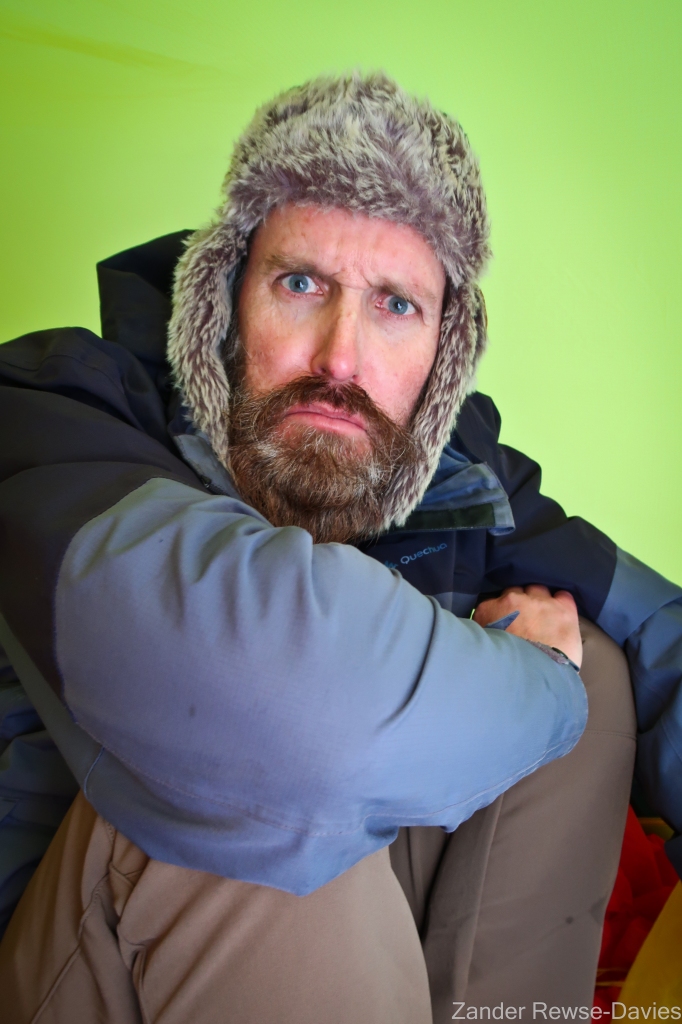
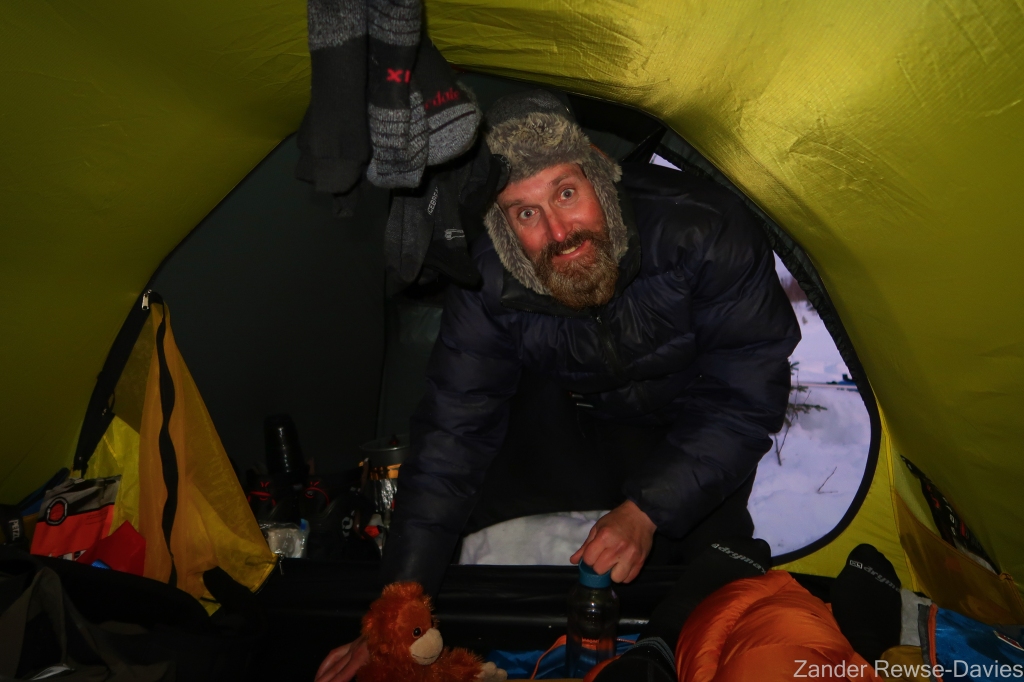
Having made camp with some relief, we settled down to a delicious hot dinner and a swig of single malt while Armageddon raged around us. I dare say that spirits were high following our small but not inconsequential victorious battle of the previous hours. Luckily our tree lined knoll offered significant shelter against the ravages of mother nature, but nevertheless, it was not a particularly peaceful night. Aside from the tent walls billowing noisily, I was also kept awake with unwelcome anticipation with every particularly strong gust. Yet, despite the fury swirling around our tent, and dangerously high temperatures having befallen us, it was great to be back in Sarek! We were even briefly treated to a miniature Aurora Borealis. While this was barely a sneak peek compared to the spectacle that I had been lucky enough to witness two years previously, it was no doubt a good omen.
Day 2


After a questionable night’s sleep and a hearty breakfast of porridge, courtesy of Expedition Foods (channelling his inner Brit, Ian had opted for a curry breakfast), we set off across the next lake. Wind scoured, our path was lined with sheet ice for the majority of the exposed sections. While this allowed for good progress, it proved to be mentally draining as our skis struggled for purchase on the slippery ground, yet we made good time. Our pace only slowed through the trees where storm debris had littered the route with fallen branches and wayward pinecones which played havoc with my delicate mohair skins, shredding them mercilessly and further robbing me of needed grip. Shortly after midday we happened upon a pair of typically outgoing Swedes, pausing only to mutter a short comment on Hector the cuddly orangutan who was riding atop of my pulk. Having only done a short tour, they could provide no helpful insights as to the conditions on the Rapadalen river further ahead. Helpfully, Ian had impressed them with his ground-seeking skills as he tumbled just in front of them.
“Within just two short days I was having to replace my skins”
Not content with letting Ian steal the limelight, I later had to make a shameful retreat to chase an errant ski which had made a bid for freedom down the hill during a steep climb which required us to resort to hauling up in just our boots. Having covered a modest fourteen and a half kilometres and wanting to save our valiant feet, we stopped for the night in a small forest which provided ample pine fodder for securing the tent to. While we waited for the snow to harden, again, I surveyed the damage to my skins caused by the stricken branches ripped from nearby trees which lined our path. Within just two short days I was having to replace my skins; a worrisome turn given that I only had one good nylon pair remaining, albeit a sturdier material but at the cost of glide. Faced with a steep hill the following day, I was sure that my tattered mohair pair would not do what was to be asked of it. Having not received my additional set in time due to the fiasco that is the Brexit customs system, I would have to resort to the grippy set that Ian had hastily obtained for me upon his arrival in Kiruna before our drive to Kvikkjokk.
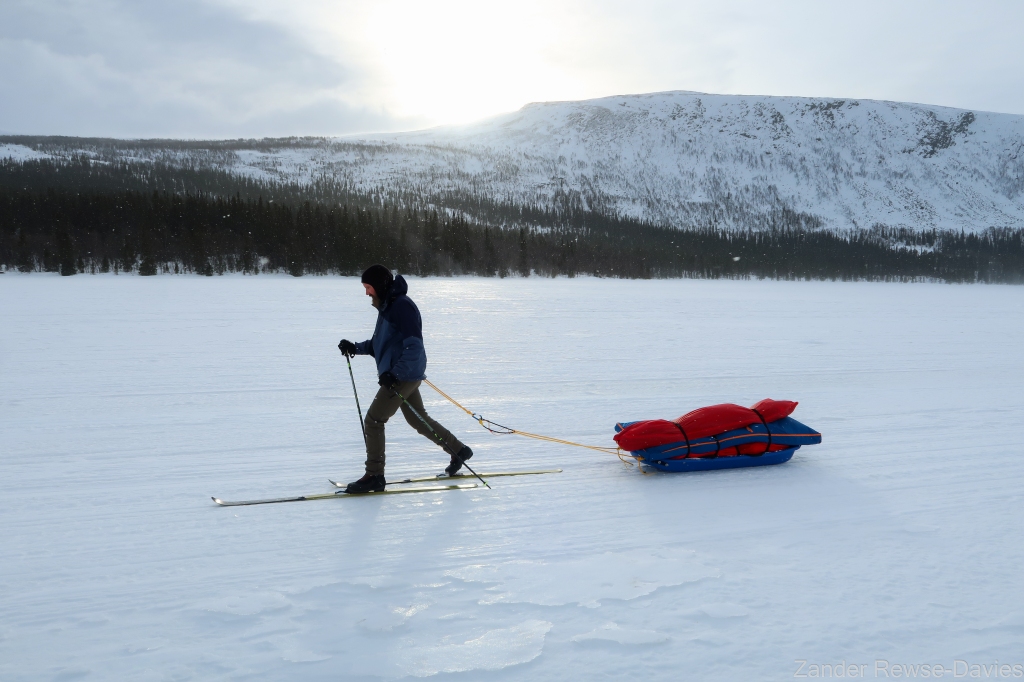
With lessons learned from our previous day, we had built our temporary palace in a shaded spot but again plagued by deep snow. It was here that we discovered that I had an uncanny ability to ‘find the holes’ as Ian would often remark. In reality, even after many hours of cementing, the snow would not be sufficiently load bearing as to support my bulk, even with my large feet (affectionately referred to as ‘canoes’ by my family). Thus, I often found myself plunging to my waist while simply trying to navigate around camp; hilarious to those observing, tiresome for the victim. Once in the tent I discovered that I had just one small blister that had cropped up on my right heel, and only a slight soreness of the muscles. The former was easily remedied the next morning with a Compeed plaster and the latter was largely to be expected. Certainly, in comparison to my previous misadventure, I was in fine fettle and excited for tomorrow when we would be entering the Rapadalen valley. It would be from there on that the real adventure would begin.
“I often found myself plunging to my waist while simply trying to navigate around camp”

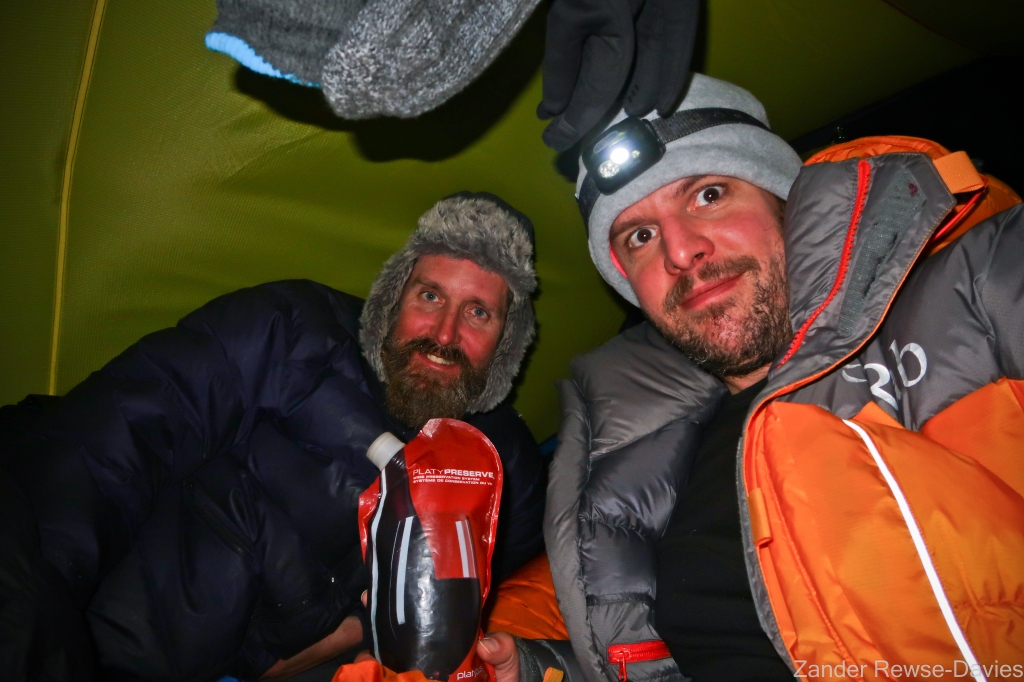
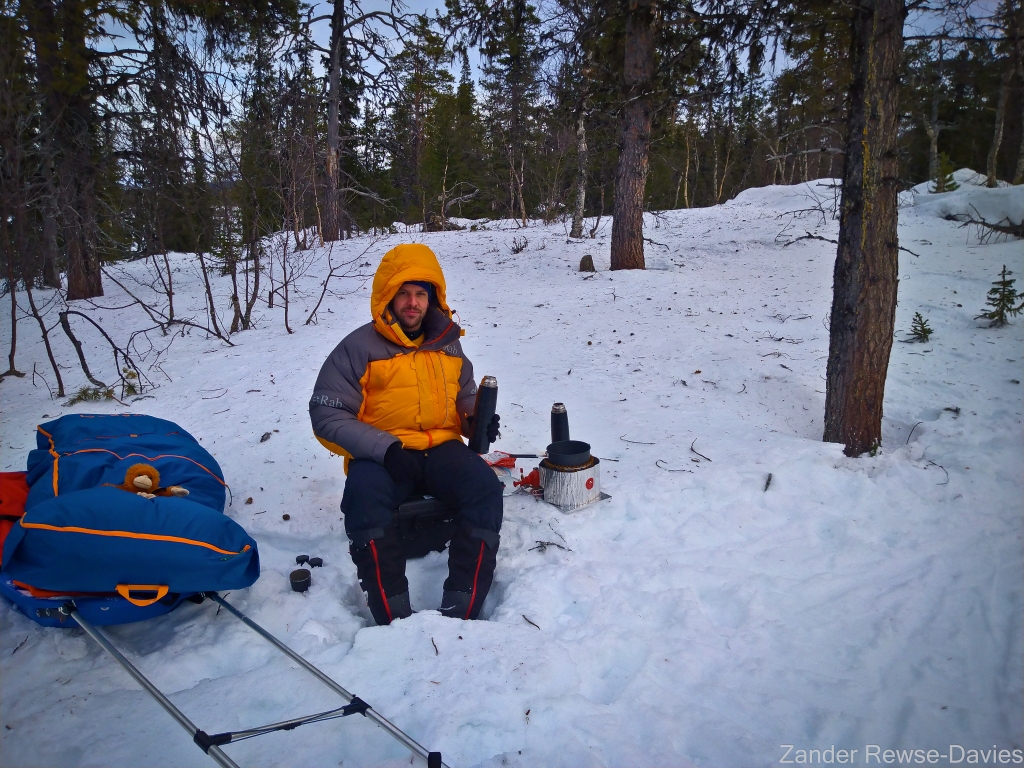
Day 3
The following day began with much anticipation, for me at least given my history here, and we set off in good sunlight on heavily rutted ice. The skiing wasn’t pleasant but the greater purpose drove us on. It wasn’t long before we crossed the great Tjaktjajávrre lake which had produced so many spectacular ice sculptures on my previous adventure. This occasion was no different and the lake art did not disappoint; thrusting rocks through meter thick ice and giant ridges and cracks perpetrating the landscape. The cause of this icy anarchy was a hydroelectric dam dozens of kilometres further down which resulted in the level of the lake dropping and causing the spectacular upthrusts which littered our passage. One such giant ridge left a sizeable icy descent, complete with drop-off, that I had failed to judge properly and thus had a rapid and stern discussion with the ice at the bottom which shredded my right hand and glove. Ian, ever helpful, had waited at the bottom to film the event while failing to point out the better line which avoided the drop.
“I had a stern discussion with the ice which shredded my right hand and glove”

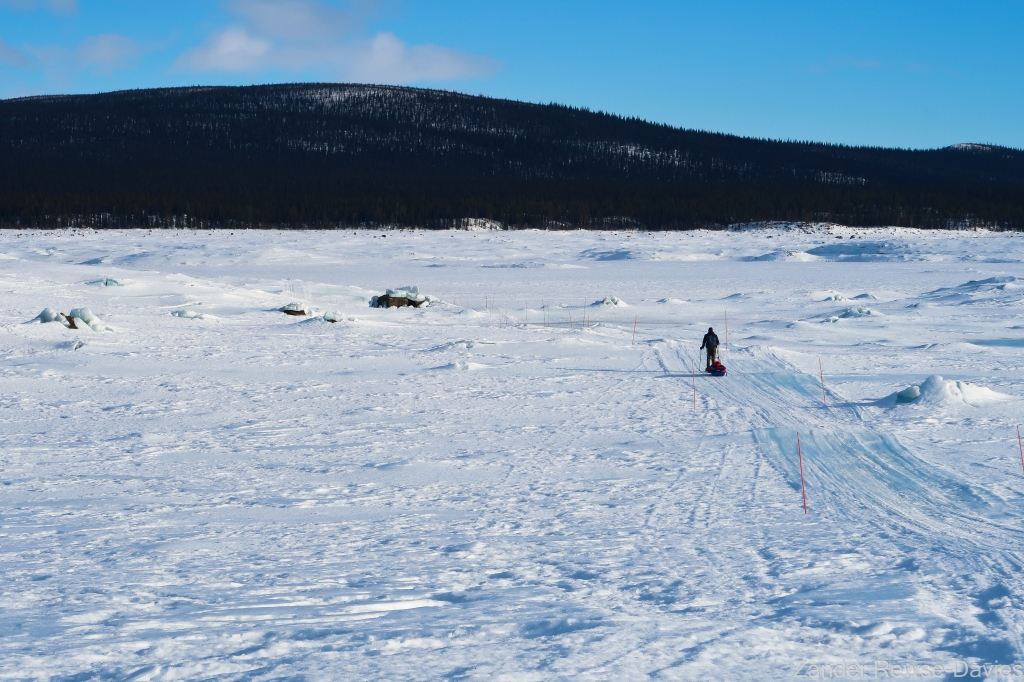

Karma would soon return the favour though. At the other side of the lake we climbed up another familiar hill to its crest where, two years previous, I had camped out on my return leg and briefly regretted my decision to turn back following a surprisingly smooth night where everything fell into place, despite my wrecked feet. When I had descended this hill back in 2021, I was sporting a pair of Alpine skis and boots which made the whole experience rather manageable. However, on this occasion, the icy slopes, tight turns and undulations made the entire descent mildly terrifying with very little semblance of control throughout. How I managed to get to the bottom with an unwieldy pulk attacking me from behind, while avoiding a tumble, is a mystery, but it certainly got my pulse racing. Ian, on the other hand, fell victim to Karma’s cruel humour. Having switched from the troublesome rope hauling method to the more conventional Scandi-bars, his pulk had taken exception to the missed opportunities to ram him from behind. Instead, it chose to give him a timely shove, resulting in his rather spectacular face plant at the bottom of a mad toboggan run.
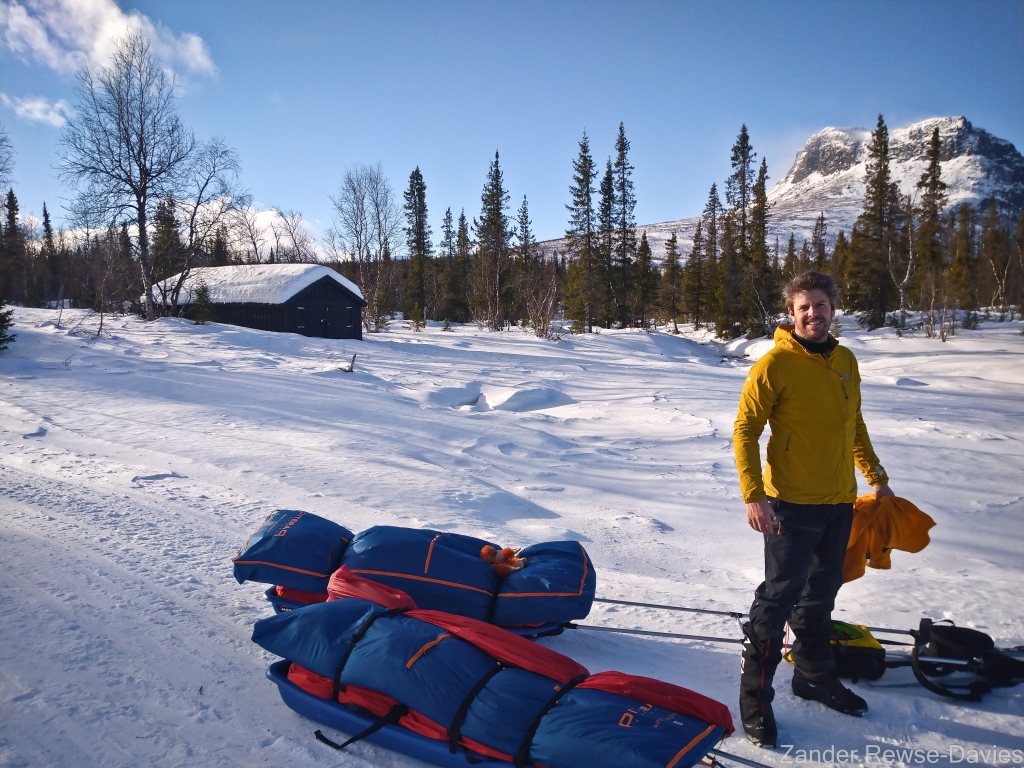
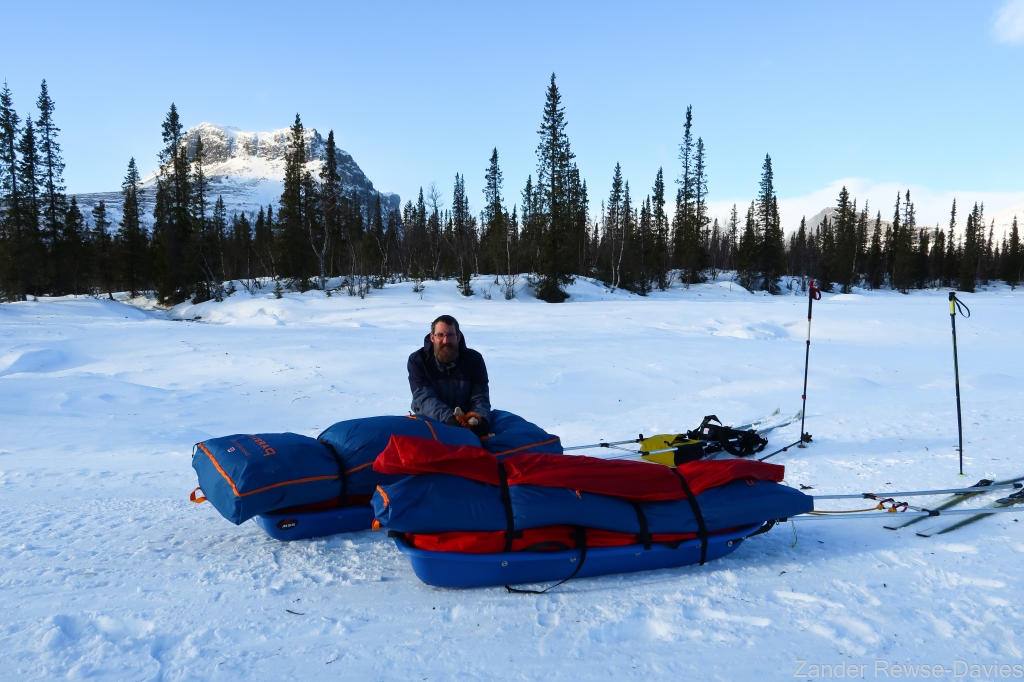
It was at the bottom of this hill, however, that was the gateway to that beautiful valley which has frequented my thoughts on many an occasion for the last couple of years. It was here that we would leave the diabolically chewed up park ranger’s snowmobile track for the great Rapadalen valley. Sympathetic to our cause, the clouds had once again parted to reveal the guardian of the Rapa; the mighty Nammatj. From here our progress slowed considerably as, despite having the luxury of a relatively fresh pulk track ahead of us, the semi-frozen crusty snow sapped every ounce of our energy. To compound my suffering, the balls of my feet had started to complain, much as they did two years previously. Resolute that I would not be scuppered by such trifling matters as foot pain, I put it to the back of my mind and pushed through.
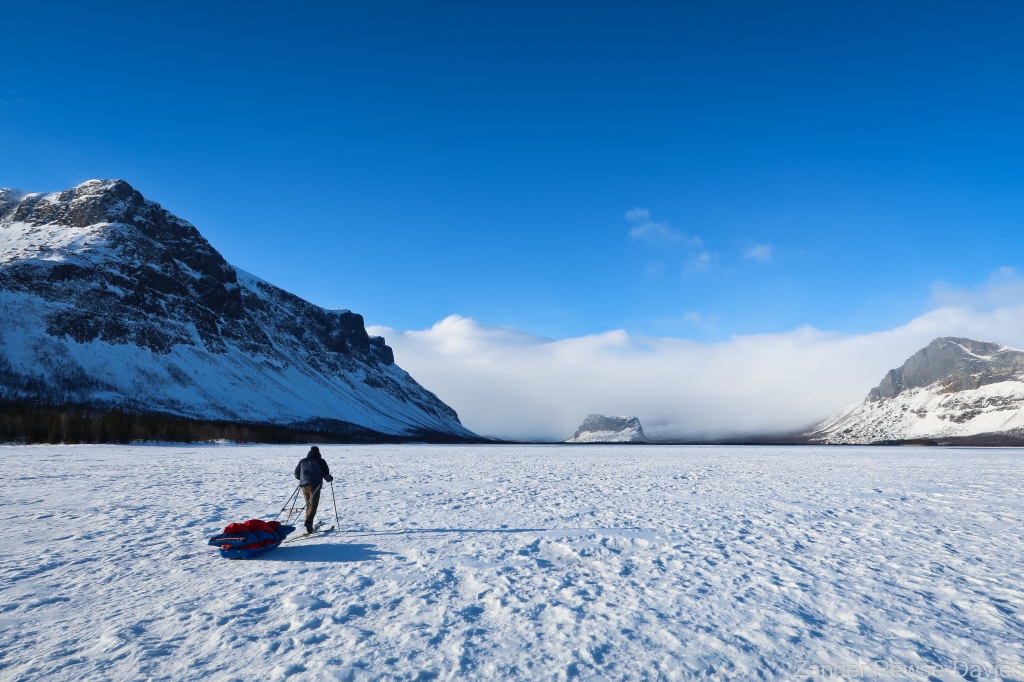
As we progressed towards Nammatj, we passed the point where I had to turn back previously with heavy heart, a somewhat personal milestone in this expedition, and headed from the wide lake to the river delta proper. Once again the wind here had decided to test our resolve. As well as now being a strong headwind, it had scoured the river ice of any grippy snow. At times we found ourselves simply skating on ice which would not look out of place in your gin & tonic; a clear polished surface as though glass. We shuffled along tentatively, often with no sign of any track that had once guided the way. While we were still quite a few kilometres from the section of the Rapa which harboured a deadly reputation, there were plenty of patches of ice so clear as to be masquerading as open water, while a handful appeared to be worryingly the other way around.
“At times we found ourselves simply skating on ice which would not look out of place in your gin & tonic“
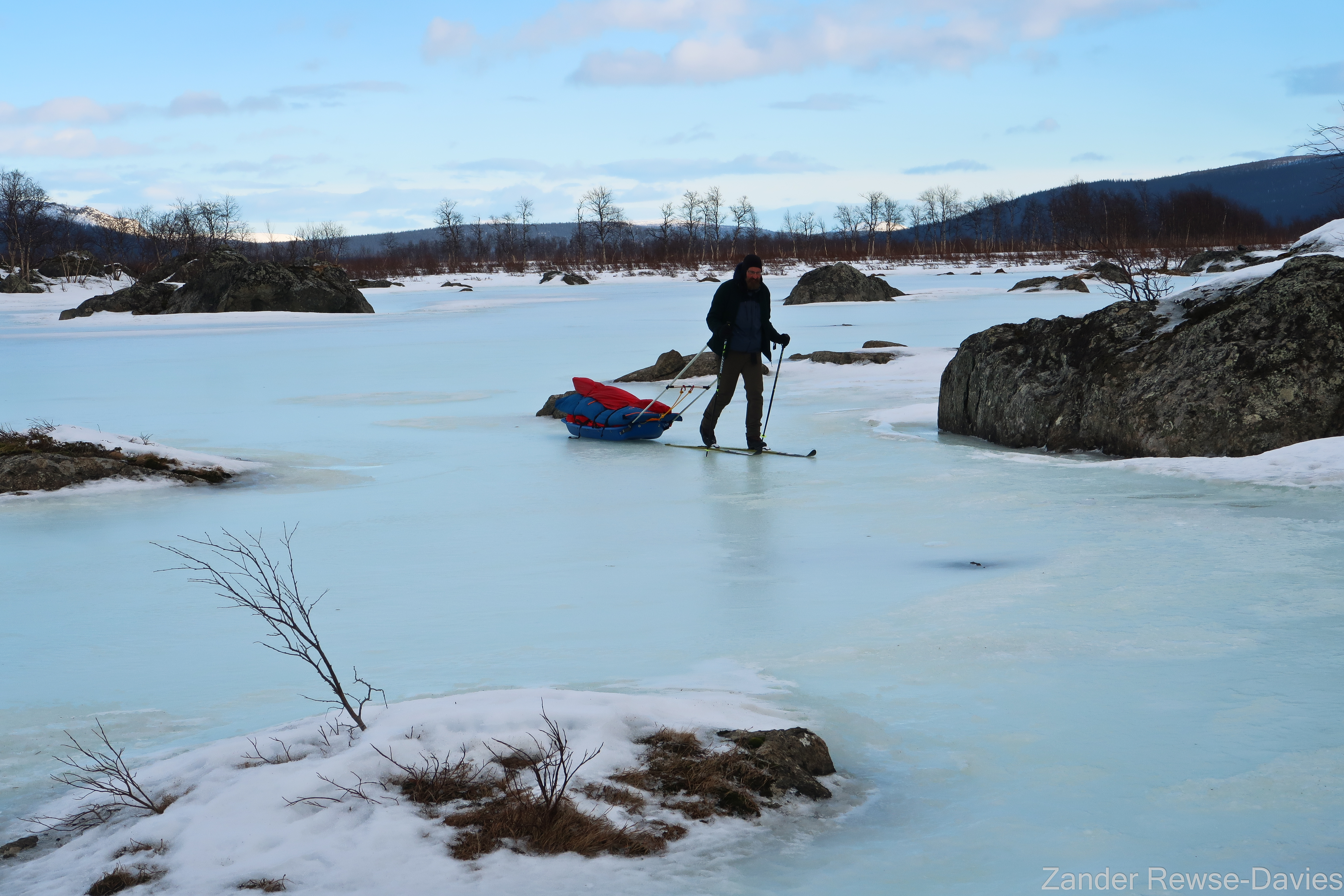

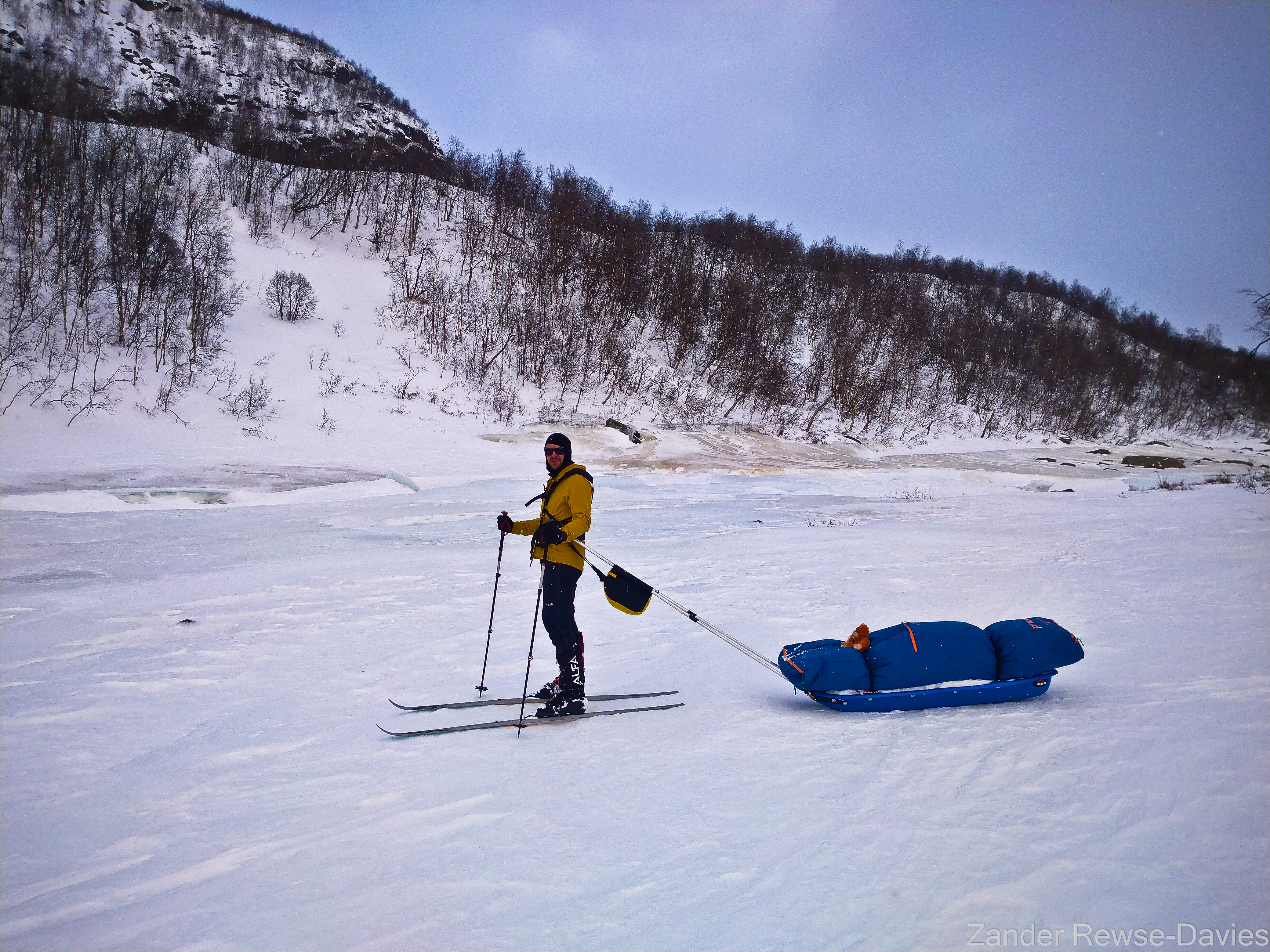

Under the shadow of the guardian of the Rapadalen, we found a suitable hill lee in which to pitch our tent out of the wind, and trees upon which to secure our insurance. We dug the obligatory snow holes in the porches to allow for relative comfort in sitting and proceeded with the ever tedious task of boiling many litres of water from debris laden snow. Such was the weather that I had even found water sloshing about in the base of my pulk from the spoils of windblown snow. Having reached further in three days than I had previously in five, we treated ourselves to a well-earned dessert of chocolate pudding after our freeze dried curries. I don’t know whether it was just the setting, but it certainly ranks as one of the best chocolate puddings that I’ve ever had. Hats off to Expedition Foods for that treat. After a minor adventure up the local hill, struggling in waist deep snow to spy the route ahead, I returned and settled down for the night brimming with optimism for our progress thus so far achieved.
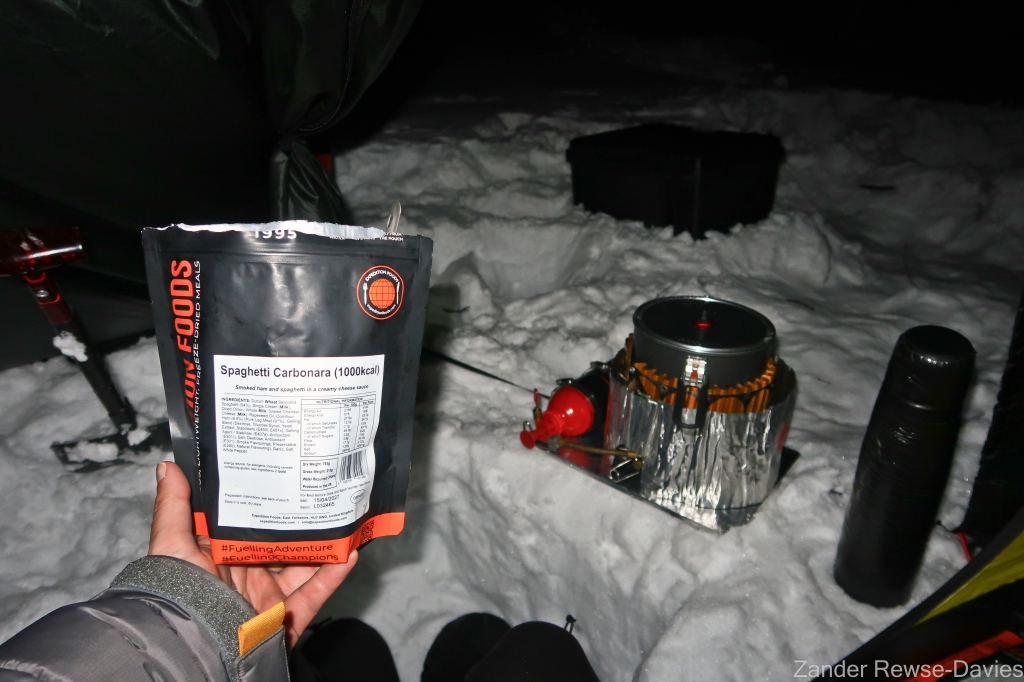


Day 4
For once we managed to resist the ever present temptation to waste the morning away in our sleeping bags. Instead, we were up in proper time. It of course helps when the temperature in the tent is above freezing, rather than being woken at -30 with snow raining down on one’s face. It helps further when one is looking forward to one’s grub; freeze dried scrambled eggs and caramelised onions might sound rather horrid to some, but I can assure you that in the wild this is a breakfast of champions which lacks only a touch of bacon. After polishing off every morsel of breakfast, I led our motley troop up the valley following traces of pulks before us, greeted by spectacular views of the sheer mountain faces around us.
“Unfrozen waters and suspended ice hid doom below”
While occasionally plagued by cloud, the sculpted valley with its delta-like river proved their draw to many an adventurer. However, amongst the towering cliffs there lay our first real danger ahead; we would soon be approaching the notorious part of the river which I had been warned about by Paul (the seasoned ex-military adventurer I had crossed paths with many times on my first Sarek expedition). Unfrozen waters and suspended ice which hid doom below had been in my mind for some time in the planning of this trip. It had been marked on my map with large Xs for the past two years. What would be the reality that awaited us? As we passed the great rock Nammatj, standing guard over the Rapa valley, I paused for a moment to ask for safe passage so that we might pass the hazards unharmed.


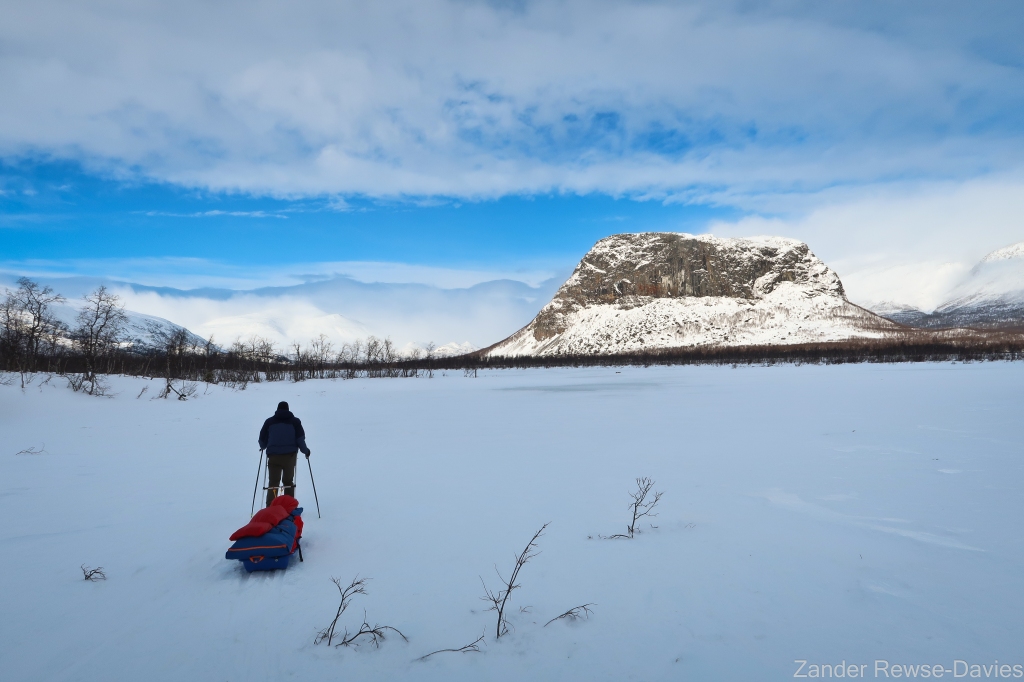
Perhaps my request was unheeded, or simply not heard over the howling winds, but soon after passing Nammatj, any traces of the old pulk track once again went cold. Without the comfort of knowing that ice had supported a person’s weight before us, we turned off the river ice and chose instead to haul our loads through deep snow and inconveniently placed trees on the western bank of the river. Exhausted as we were in these sluggish conditions, we began to question whether we were really wise to fight through the snow or should try our luck on the perilous ice. Nearing a bank of the meandering river, we soon found our caution most justified. Large stretches of water were completely free of ice, owing in part to the fast flowing water which prevents freezing, but no doubt aided by the mild temperatures. Attempting to navigate the river in this section would most surely result in plunging through thin ice to one’s frozen demise. Onwards we struggled until we stopped for a break at an old weather station, half buried in snow, where we again found traces of a track.
“Large stretches of water were completely free of ice”
Buoyed by our rediscovery of easier passage and fuelled by a welcome refreshment of tea & cake, we followed the trail past further open water channels until it brought us back out onto the ice of a side stream which ran parallel to the winding Rapadalen. The ice here was largely in good fettle and skiing was mostly concern-free, aside from the usual risk of falling flat one’s face. Following the track led us to a crossing that weaved through small patches of open water; clearly it has supported those before us, but one can’t assume that good ice for a light chap on one day is still supportive for a larger gent the next. After a brief yet sober discussion, we opted to proceed and Ian led the way across this decidedly dodgy ice channel. Aside from one of Ian’s poles breaking through the ice next to his skis, we made it across without incident, much to our relief. After again losing the path, we snaked our way along a mix of wooded hills, snowy banks and icy stretches of river, all the while facing an increasingly tedious headwind.

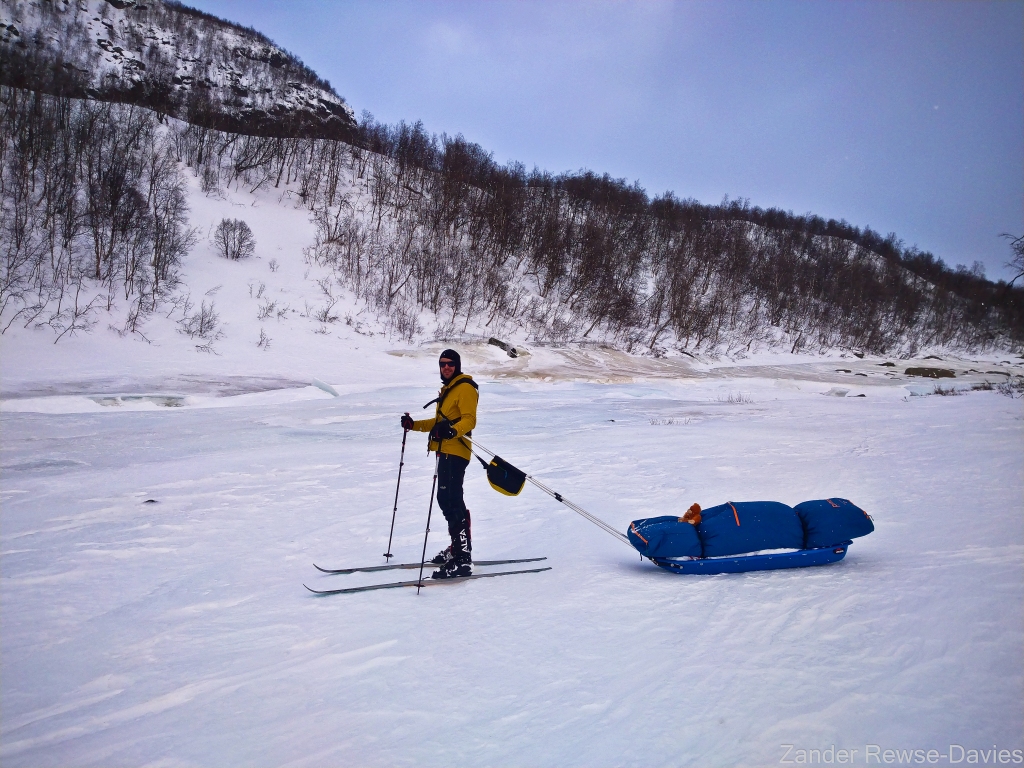
The next crossing of concern was of a tributary to the Rapa which tumbled down from a beautifully carved valley above, veiled in low cloud. Given the steep run of the water for the most part, it would likely be fast paced which is a recipe for thin or absent ice. With a delicate carpet of pristine white snow, I could see that there were no open patches of water but there was no way of knowing how thick the ice was below. With it my turn to play the role of sacrificial canary, with some trepidation I inched across the river, being careful not to make sudden movements which might wake the sleeping beast below. Thankfully I managed to reach stable ground on the far bank and Ian followed in my wake.
“The only way forward was across narrow snow and ice bridges which delicately spanned frothing black waters below”
These careful crossings would just be the start of an incredibly interesting day that would contain trials one would normally be accustomed to when traversing a glacier. As the valley narrowed, the banks became steeper and strewn with huge boulders flung from their mountain perches; passage here became practically impossible. As such, we were forced to navigate on the tortuous river as it flowed down over rocks and ledges, negotiating outcrops and hillocks in its path. As a test of our newfound Nordic skiing skills, we clambered up the sides of partially frozen rapids while hauling our heavy pulks up the steep ice, just a foot away from gushing icy waters. This would be an unfortunate location to lose one’s balance. To add to the spiciness of our adventure up the rapids, sometimes the only way forward was across narrow snow and ice bridges which delicately spanned frothing black waters below. These traverses certainly raised the blood pressure and Ian was quite unimpressed when I paused for a photo atop of one. However, we soon learned what was possible to slide a heavy skier and pulk across without plunging through and our fears became gradually dulled as our confidence grew in navigating these freezing hazards. It is always surprising how effective skis are at spreading the most hefty of loads, although the consequences of confidence misplaced don’t bear thinking about.


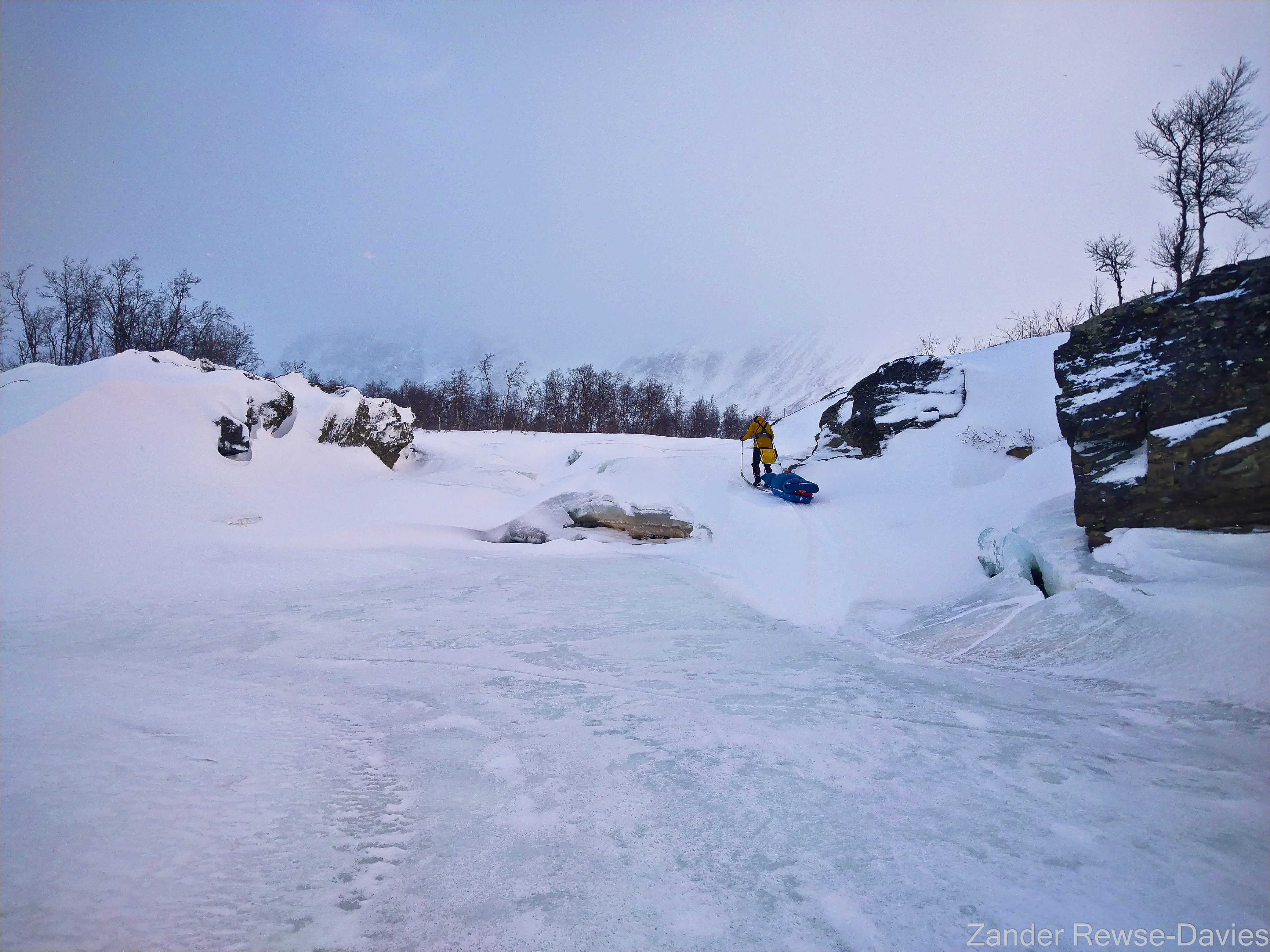
The challenges of the route meant that only sixteen kilometres were managed that day, and certainly at the expense of significant effort and mental calculation. Despite this, the day was quite enjoyable, for adventure, stunning views and self-education are a better drug than any could conjure, and tomorrow we would be served more of this tonic. With the winds still relentless, albeit lacking their previous fury, we chose to build a small snow wall at our campsite to divert the worst over the tent, before proceeding the familiar rigmarole of transforming a large pile of snow into life-giving fluid and sustenance. Day four was one of great satisfaction and no small measure of excitement. With a stark change in the weather forecast, the next leg of our expedition would lead us to climb deep into the mountains where surprises and wonder lay ahead of us. I had thought that the Rapa valley would be the highlight of our adventure but even this would be trumped by the beauty of a classic Arctic landscape.
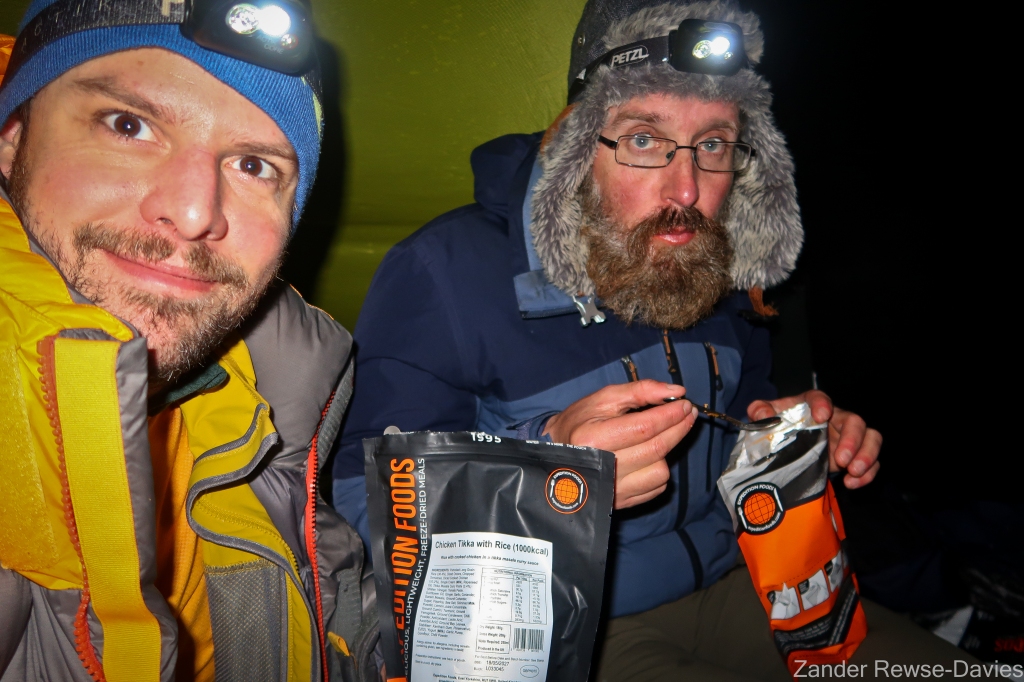
Do you want to know how the rest of my adventure went? I will publish the next part of my story shortly. Sign up below if you would like to be notified about new posts on this website and follow me on my adventures!

Want to stay updated on the latest adventures?
I have only just begun to tell the many stories of my adventures. Stay connected to learn about past, present and future expeditions.

